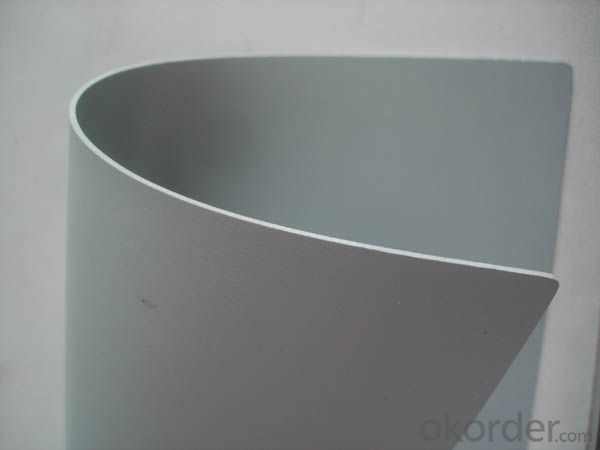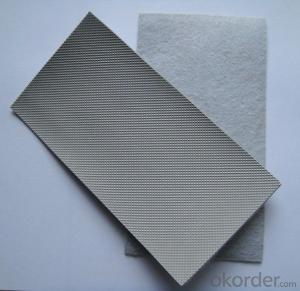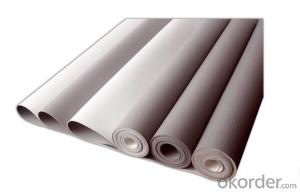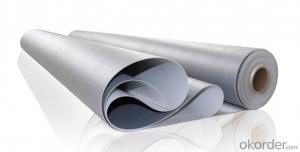High Polymer Waterproofing Membrane Polyester Nonwoven Reinforced
- Loading Port:
- China main port
- Payment Terms:
- TT OR LC
- Min Order Qty:
- 5000 m²
- Supply Capability:
- 100000 m²/month
OKorder Service Pledge
OKorder Financial Service
You Might Also Like
Specification of PVC Waterproofing Membrane
Length | 20m/roll or customized |
Width | 2.05m |
Thickness | 1.2mm; 1.5mm; 2.0mm |
Type | Homogeneous, Reinforced, Fabric back |
If Exposed | Exposed and Non-exposed |
Color | White, Grey or customized |
Introduction of PVC Waterproofing Membrane
Polyvinyl Chloride (PVC) waterproof membrane is a new polymer waterproof membrane which is made from polyvinyl chloride resin, and mixed with plasticizer, filler, antioxygen, ultraviolet absorber and other auxiliaries.
Features of PVC Waterproofing Membrane
1) Excellent aging resistance. Service life of roofing material is over 20 years;
service life of underground material is over 50 years.
2) Root resistant penetration, specially used on planting roof.
3) Welding installation. Joints are solid and environment friendly, no pollution.
4) High tensile strength, good elongation and dimensional stability.
5) Good plasticity, easy and suitable for details installation.
6) Fireproof. Fire extinguished out of the ignition resource.
7) Surface is smooth, no fading and dirty resistant.
Types of PVC Waterproofing Membrane
N1—Exposed PVC waterproof membrane.
(It is mainly used as details treatment for exposed roof waterproof project)
N2—Non-exposed PVC waterproof membrane.
(It is mainly used as details treatment for non-exposed roof waterproof project)
L1—Exposed PVC waterproof membrane with fabric.
(It is mainly used for exposed roof waterproof project)
L2—Non-exposed PVC waterproof membrane with fabric.
(It is mainly used for non-exposed roof waterproof project)
W1—Exposed reinforced PVC waterproof membrane .
(It is mainly used for steel structure roof exposed waterproof project)
W2—Exposed reinforced PVC waterproof membrane .
(It is mainly used for steel structure roof non-exposed waterproof project)
FAQ of PVC Waterproofing Membrane
a.Can we get some samples before place order?
Answer: We can send the free samples to you by freight collect.
b.How many years can your PVC membrane guarantee?
Answer: We will guarantee the quality for 5 years at least.
c.Which countries you ever export the product?
Answer: We export the PVC membrane to South Africa, Middle east and even European countries.

- Q:Can a waterproofing membrane be used for bridge decks and roadways?
- Yes, a waterproofing membrane can be used for bridge decks and roadways. Waterproofing membranes are designed to provide a protective layer that prevents water infiltration, which is essential for the long-term durability and performance of bridge decks and roadways. These membranes help to prevent water damage, such as corrosion and cracking, and also protect the underlying structure from moisture-related issues.
- Q:Can a waterproofing membrane be used in hospitals or healthcare facilities?
- Yes, a waterproofing membrane can be used in hospitals or healthcare facilities. In fact, it is highly recommended to use waterproofing membranes in these settings due to the critical need for maintaining a clean and hygienic environment. Waterproofing membranes are typically applied on floors, walls, and ceilings to prevent water or moisture infiltration, which can lead to mold growth, deterioration of building materials, and compromise the structural integrity of the facility. By using waterproofing membranes, healthcare facilities can effectively protect against water damage, facilitate easier cleaning and maintenance, and prevent the growth of bacteria and other harmful microorganisms. Additionally, waterproofing membranes can also help in managing moisture levels, thereby reducing the risk of slips and falls, which is especially crucial in areas where patients, staff, and visitors frequent. Overall, waterproofing membranes are a valuable asset in ensuring the safety, durability, and cleanliness of hospitals and healthcare facilities.
- Q:Can a waterproofing membrane be used on concrete tanks?
- Yes, a waterproofing membrane can be used on concrete tanks. A waterproofing membrane is designed to provide a barrier against water penetration and can be applied to various surfaces, including concrete. Concrete tanks, such as those used for water storage or containment, can benefit from the use of a waterproofing membrane to prevent water leakage or seepage. The membrane is applied to the concrete surface, creating a protective layer that prevents water from entering or exiting the tank. This can help to maintain the structural integrity of the tank and prevent any potential damage or contamination caused by water leakage. Additionally, waterproofing membranes can also provide protection against other substances, such as chemicals or pollutants, that may be present in the tank. It is important to choose the appropriate type of membrane for the specific requirements of the concrete tank and to follow the manufacturer's instructions for application to ensure effective and long-lasting waterproofing.
- Q:Does a waterproofing membrane require any specific curing time before it can be exposed to water?
- Yes, a waterproofing membrane typically requires a specific curing time before it can be exposed to water. The curing time allows the membrane to fully bond and form a protective barrier against water penetration. This time frame can vary depending on the type of membrane and manufacturer's instructions. It is crucial to adhere to the recommended curing time to ensure the membrane's effectiveness and durability. Premature exposure to water before the curing process is complete could compromise the membrane's performance and lead to water leakage or damage. Therefore, it is essential to follow the manufacturer's guidelines and allow the necessary curing time before subjecting the waterproofing membrane to water.
- Q:Are waterproofing membranes suitable for exterior use?
- Yes, waterproofing membranes are suitable for exterior use. These membranes are specifically designed to provide a barrier against water penetration and are commonly used in various exterior applications such as rooftops, balconies, and foundations. They are made from durable materials that can withstand exposure to harsh weather conditions, UV rays, and temperature fluctuations. Waterproofing membranes help to prevent water damage, moisture buildup, and potential structural issues caused by water infiltration. Additionally, they can be applied to different types of surfaces including concrete, metal, and wood, making them versatile for various outdoor environments. Overall, waterproofing membranes are a reliable solution for protecting exterior surfaces from water damage and prolonging their lifespan.
- Q:Can a waterproofing membrane be installed on vertical surfaces without causing sagging or drooping?
- Yes, a waterproofing membrane can be installed on vertical surfaces without causing sagging or drooping. The key to preventing sagging or drooping is to ensure proper installation techniques and use of appropriate materials. Firstly, it is important to select a high-quality waterproofing membrane specifically designed for vertical applications. These membranes are typically more rigid and have better adhesion properties, allowing them to adhere firmly to the vertical surface without sagging. Secondly, the surface preparation is crucial to ensure a strong bond between the membrane and the vertical surface. The surface should be thoroughly cleaned, free from any debris, and properly primed before applying the membrane. This helps to establish a solid foundation for the membrane and prevents any potential sagging or drooping. Thirdly, proper installation techniques should be followed. It is important to apply the membrane in a smooth and even manner, avoiding any excessive stretching or folding that could cause sagging. Additionally, any seams or overlaps in the membrane should be carefully sealed to maintain a watertight barrier. Furthermore, it is recommended to use mechanical fixings such as screws or nails to secure the membrane in place. These fixings help to provide additional support and prevent any potential sagging over time. Overall, with the right selection of materials, proper surface preparation, and careful installation techniques, a waterproofing membrane can be installed on vertical surfaces without causing sagging or drooping.
- Q:Can waterproofing membranes be used on concrete surfaces?
- Concrete surfaces can indeed benefit from the use of waterproofing membranes. These membranes are specifically designed to create a barrier against water penetration. They are often employed on concrete surfaces to safeguard them against water damage. Typically, these membranes are composed of rubber, PVC, or bitumen and can be applied to the concrete surface either in a liquid or sheet form. Once applied, the membrane forms a strong and continuous waterproof layer that effectively prevents water from seeping into the concrete. This proves to be particularly advantageous in areas that frequently come into contact with water, such as basements, bathrooms, or outdoor concrete structures. By preventing water-related issues such as cracking, spalling, or mold growth, waterproofing membranes effectively prolong the lifespan of concrete surfaces.
- Q:Can a waterproofing membrane be used on precast stone surfaces?
- Indeed, the utilization of a waterproofing membrane is viable on precast stone surfaces. Similar to all other concrete or masonry surfaces, precast stone surfaces are prone to water infiltration, which may lead to long-term damage. By applying a waterproofing membrane onto the precast stone surface, one can effectively prevent water penetration and shield the stone from moisture-related problems such as cracking, spalling, and efflorescence. This membrane establishes a barrier that hinders water seepage into the stone while still permitting it to respire and release any trapped moisture. Hence, it is crucial to select a waterproofing membrane that is compatible with the precast stone material and meticulously adhere to the manufacturer's instructions for proper application.
- Q:Can a waterproofing membrane be used on iron surfaces?
- Indeed, iron surfaces can benefit from the utilization of a waterproofing membrane. Normally composed of rubber, bitumen, or polyurethane, these membranes are specifically engineered to establish a barrier against water and moisture. They possess the capacity to adhere to diverse surfaces, including iron, and offer safeguarding against water penetration. By applying a waterproofing membrane in a precise manner, one can successfully seal and waterproof iron surfaces, effectively deterring corrosion and prolonging the material's longevity. It is of utmost significance to select a waterproofing membrane that is compatible with iron and meticulously adhere to the manufacturer's guidelines regarding installation and upkeep.
- Q:Can a waterproofing membrane be used in conjunction with insulation materials?
- Yes, a waterproofing membrane can be used in conjunction with insulation materials. The membrane acts as a barrier to prevent water infiltration, while insulation materials provide thermal resistance to control heat flow. This combination is commonly used in construction to ensure both waterproofing and insulation performance.
1. Manufacturer Overview |
|
|---|---|
| Location | |
| Year Established | |
| Annual Output Value | |
| Main Markets | |
| Company Certifications | |
2. Manufacturer Certificates |
|
|---|---|
| a) Certification Name | |
| Range | |
| Reference | |
| Validity Period | |
3. Manufacturer Capability |
|
|---|---|
| a)Trade Capacity | |
| Nearest Port | |
| Export Percentage | |
| No.of Employees in Trade Department | |
| Language Spoken: | |
| b)Factory Information | |
| Factory Size: | |
| No. of Production Lines | |
| Contract Manufacturing | |
| Product Price Range | |
Send your message to us
High Polymer Waterproofing Membrane Polyester Nonwoven Reinforced
- Loading Port:
- China main port
- Payment Terms:
- TT OR LC
- Min Order Qty:
- 5000 m²
- Supply Capability:
- 100000 m²/month
OKorder Service Pledge
OKorder Financial Service
Similar products
New products
Hot products
Hot Searches
Related keywords




























